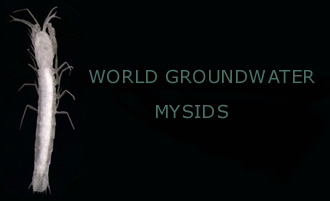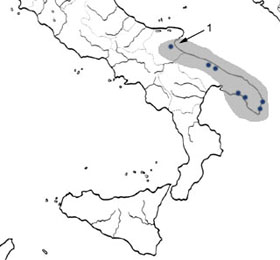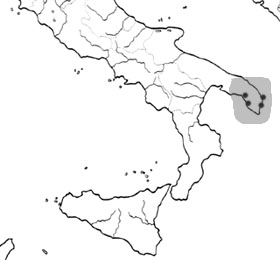 In the present, provisional inventory, World subterranean stygobitic fresh and anchihaline water species, as well as stygophilic species from land crab burrows, prawn culture fields and interstitial coastal belts are listed.
Species described before 1994 according to Pesce, Juberthie-Jupeau & Passelaigue (1994) review. Information and/or suggestion regarding new described species or species described after 1995, as well as improving of the list, will be welcome. Please contact the following address: pesce@univaq.it
Crustacean mysids can be found throughout the oceanic water column and are also found in freshwater environments as well. Some mysids feed on small particles which they collect by grooming their body surface, whereas others are predacious on other zooplankton. Some mysids are scavengers. Marine mysids often are found in large swarms and are an important part of many fish diets. Mysids are also called "Opposum shrimp", because of the brood pouch present in all mature females.
Mysids at present include more than 1000 species, widespread over all the continents, inhabiting coastal and open sea waters, as well as continental fresh waters, several taxa occuring also in different groundwater habitats and in anchialine caves. Among the subterranean mysids, most species are stygobiontes, a few are stygophiles, in this last case, adaptation to groundwater life is limited to reduction of eyes and/or body pigment. Some marine species reported from coastal caves do not exhibit ramarkable adaptation or specialization to the subterranean habitat. True stygobitic groundwater mysids successfully colonized central America,
the Caribbean area and the Mediterranean basin; only three stygophilic species are known outside of these regions, viz. Spelaeomysis longipes and Spelaeomysis cochiensis from India, and Spelaeomysis servatus from Zanzibar and Kenya. A tethyan origin is supposed for the most stygobitic mysids, with some reserve as regard the distribution patterns at specific level. At present, several groundwater taxa, most endemic, are known from coastal, marine caves, phreatic waters (wells) and anchialine habitats, the majority of which colonized the groundwater nets owing to stranding and uplifting of their marine ancestors pending the regressions of the Thetys and the Mediterranean; other taxa are more recent and stygophililes.
Spelaeomysis Caroli 1924
The genus Spelaeomysis presently includes nine named species, seven from different groundwater habitats (anchialine caves, wells) of South Italy, Zanzibar, Mexico and Cuba, one from
prawn culture fields of India , the other one from crab burrows of Colombia. Recently Garcia-Garza et al. (1996), in occasion of the description of S. villalobosi from Mexico, reported a key to the known species, including only seven species and omitting S. bottazzii and S. cochinensis, as well as mispelling S. servatus with S. serratus.
Spelaeomysis bottazzii Caroli 1924 [anchihaline and phreatic waters;
* Recently, in the course of speleological research in the ground waters of Gargano, carried out by E. Rossi and S. Inguscio (Gruppo Speleologico Martinese), with the collaboration of the "Gruppo Speleologico Dauno" and the "Speleo Club Sperone" specimens of Spelaomysis bottazzii and Typhlocaris salentina were collected . This is the most northern record of these crustaceans in the Puglia region.
 Distribution of Spelaeomysis bottazzii (1:unpublished)
The family Stygiomysidae includes a single genus, Stygiomysis, and six described stygobitic species Stygiomysis Caroli 1937 Stygiomysis hydruntina Caroli 1937 [anchihaline and phreatic waters; South Italy]
 Distribution of Stygiomysis hydruntina
Antromysis Creaser 1936 According to Bowman (1977) the genus Antromysis includes four subgenera, viz. Antromysis s.str., Anophelina Bacescu & Orghidan, 1971, Parvimysis Brattegard, 1969 and Surinamysis Bowman, 1977; the last two subgenera do not include true stygobitic species.
Antromysis (Antromysis) cenotensis Creaser 1936 [cave waters; Yucatan, Mexico] Troglomysis Stammer 1936 Troglomysis vjetrenicensis Stammer 1936 [cave waters; Yugoslavia] Heteromysoides Bacescu 1968 The genus Heteromysoides was established by Bacescu (1968) to accomodate some Heteromysinae species differing from Heteromysis by the reduced cornea, male antenna 1 represented by a knob bearing few or no setae, and pleopods not sexually dimorhic. At present the genus includes nine species, six from surface waters [H. spongicola Bacescu, 1968 (Cuba); H. longiseta Bacescu, 1983 (Australia); H. nana Murano, 1998 (Australia); H. sahulensis Murano 1998 (Australia); H.macrops Murano,1988 (Australia); H. berberae Bacescu & Miller, 1985 (Somalia)], the following three are subterranean:
Heteromysoides cotti (Calman 1932) [brackish ground waters; Canary Islands] Burrimysis Jaume & Garcia 1993 Burrimysis palmeri Jaume & Garcia 1993 [anchihaline waters; Balearic islands] Hemimysis Sars 1869
Hemimysis speluncola Ledoyer 1963 [marine caves; north-West Mediterranean] Mysidium Mysidium cubanense Bacescu & Ortiz 1984 [cave waters; Cuba] Mysidetes Mysidetes halope O'Brien 1986 [cave waters; Tasmania] Amathimysis Amathimysis sarbui Bacescu 1991 [cave waters: Caribbean] Leptomysis Sars 1869 Leptomysis burgii Bacescu 1966 [submarine caves; France] Proleptomysis Wittmann 1985 Proleptomysis peresi Bacescu 1966 [submarine caves; France] Anisomysis Hansen 1910 Anisomysis vasseuri Ledoyer 1974 [coral reef caves; Madagascar] Harmelinella Ledoyer 1989 Harmelinella mariannae Ledoyer 1989 [cave waters; North-West Mediterranean] Bermudamysis Bacescu & Iliffe 1986 Bermudamysis speluncola Bacescu & Iliffe 1986 [anchihaline waters; Bermuda] Platyops Bacescu & Iliffe 1987 Platyops sterreri Bacescu & Iliffe 1986 [anchihaline waters; Bermuda] Aberomysis Bacescu & Iliffe 1987 Aberomysis muranoi Bacescu & Iliffe 1987 [marine caves; Palau] Palaumysis Bacescu & Iliffe 1986 The genus Palaumysis was erected by Bacescu & Iliffe (1986) to accomodate mysids from marine caves of Palau (Micronesia) showing peculiar characteristics, such as rudimentary antennal scale (no scale according to the original description), apomorphic anntennal flagellum, strong peraeopods with carpopropodus not divided, and two oostegites in the females.
Palaumysis bahamensis Pesce & Iliffe, 2002 [Bahamas; anchialine cave] Heteromysis Smith 1873 Species of Heteromysis are known from different habitats, only three species have been reported from coastal ground waters(anchialine and submarine caves). Heteromysis bermudensis Sars 1885 [anchihaline waters, Bermuda]
A selected World bibliography on subterranean mysids can be found in: Th. E. Bowman (1984). Mysidacea. Stygofauna Mundi: 405-409; Pesce G.L., Juberthie-Jupeau L. & Passelaigue F.(1994). Mysidacea. Encyclopaedia Biospeologica. Societè de Biospéologie, Moulis, Bucarest: 113-119; Bowman, Thomas E., Thomas M. Iliffe, and Jill Yager. 1984. New records of the troglobitic mysid genus Stygiomysis: S. clarkei, new species, from the Caicos Islands, and S. holthuisi (Gordon) from Grand Bahama Island (Crustacea: Mysidacea). Proceedings of the Biological Society of Washington. 97(3):637-644, 4 figures.
|



